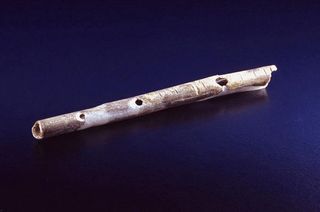Caveman Flutists? First Instruments Date Back 40,000 Years

Early modern humans could have spent their evenings sitting around the fire, playing bone flutes and singing songs 40,000 years ago, newly discovered ancient musical instruments indicate. The bone flutes push back the date researchers think human creativity evolved.
Researchers were studying a modern human settlement called Geißenklösterle, a part of the Swabian caves system in southern Germany, when they came across the bone flutes. One is made of mammoth ivory, while the other seems to be made of bones from a bird. They also found a collection of perforated teeth, ornaments and stone tools at the site.
"These results are consistent with a hypothesis we made several years ago that the Danube River was a key corridor for the movement of humans and technological innovations into central Europe between 40,000 and 45,000 years ago," study researcher Nick Conard, of Tübingen University, said in a statement.
"Geißenklösterle is one of several caves in the region that has produced important examples of personal ornaments, figurative art, mythical imagery and musical instruments. The new dates prove the great antiquity of the Aurignacian in Swabia." The Aurignacian refers to an ancient culture and the associated tools. [Gallery: Europe's Oldest Rock Art]
Old bones
The flutes are the earliest record of technological and artistic innovations that are characteristic of the Aurignacian period. This culture also

created the oldest known example of art meant to represent a person, found in the same cave system in 2008 (that statue seems to be about 35,000 years old). The musical instruments indicate that these early humans were sharing songs and showing artistic creativity even earlier than previously thought.
Sign up for the Live Science daily newsletter now
Get the world’s most fascinating discoveries delivered straight to your inbox.
The researchers radiocarbon-dated bones found in the same layer of the archaeological dig as the flutes. This carbon dating uses the level of radioactive carbon, which is naturally occurring in the world and decays predictably into nonradioactive carbon, to estimate the age of organic materials.
They found the objects were between 42,000 and 43,000 years old, belonging to the Aurignacian culture dating from the upper Paleolithic period. So far, these dates are the earliest for the Aurignacian and predate equivalent sites from Italy, France, England and other regions.
The results indicate that modern humans entered the Upper Danube region before an extremely cold climatic phase around 39,000 to 40,000 years ago, the researchers said.
"Modern humans during the Aurignacian period were in central Europe at least 2,000 to 3,000 years before this climatic deterioration, when huge icebergs calved from ice sheets in the northern Atlantic and temperatures plummeted," study researcher Tom Higham, of Oxford University, said in a statement. "The question is what effect this downturn might have had on the people in Europe at the time."
This site was inhabited by modern humans, the researchers said, but it's possible that Neanderthals were also in the area at the same time, though they haven't been able find evidence of any cultural contact or interbreeding between the two groups in this part of Europe.
The study was published May 8 in the Journal of Human Evolution.
You can follow LiveScience staff writer Jennifer Welsh on Twitter, on Google+ or on Facebook. Follow LiveScience for the latest in science news and discoveries on Twitter and on Facebook.
Jennifer Welsh is a Connecticut-based science writer and editor and a regular contributor to Live Science. She also has several years of bench work in cancer research and anti-viral drug discovery under her belt. She has previously written for Science News, VerywellHealth, The Scientist, Discover Magazine, WIRED Science, and Business Insider.

